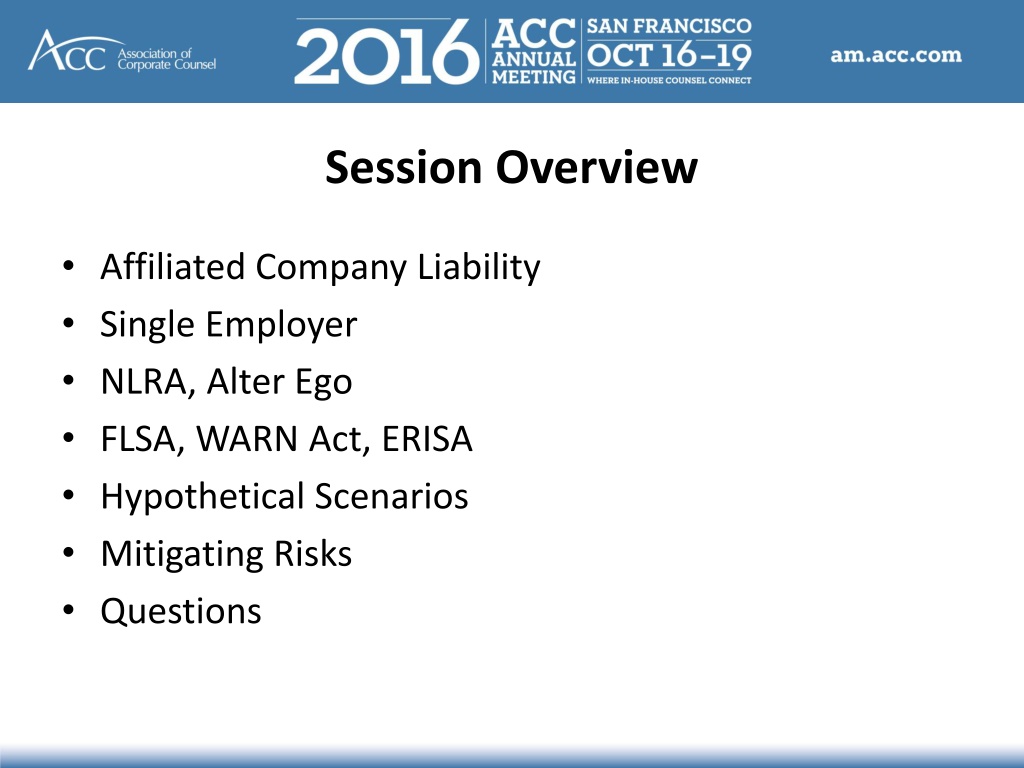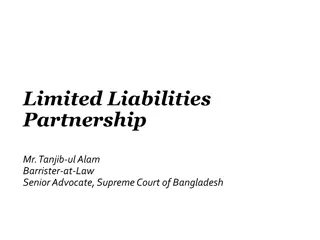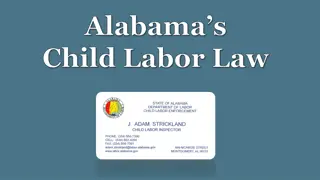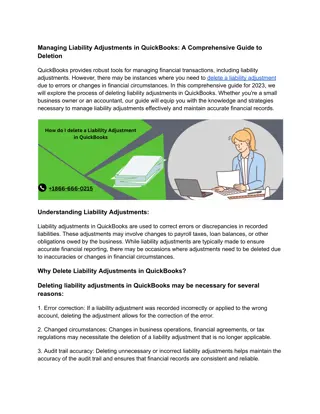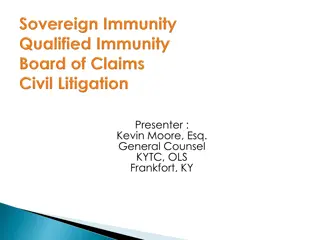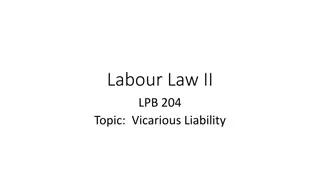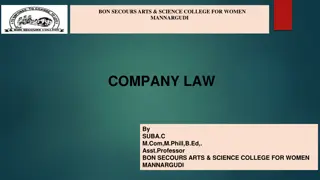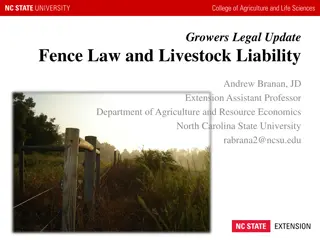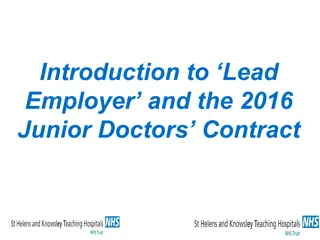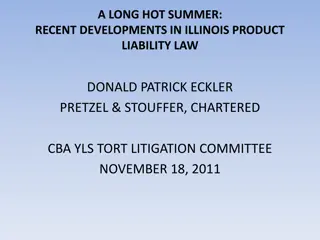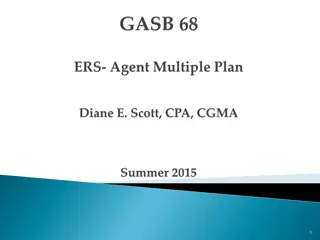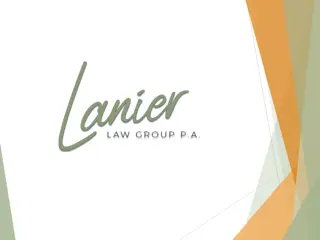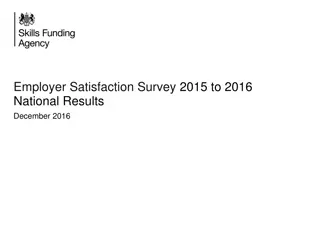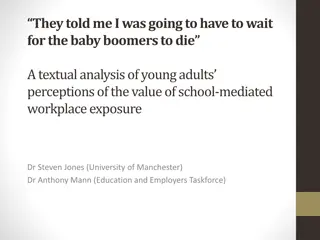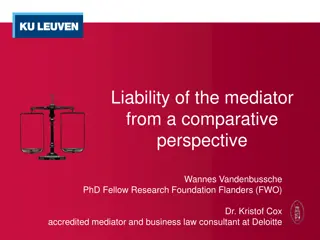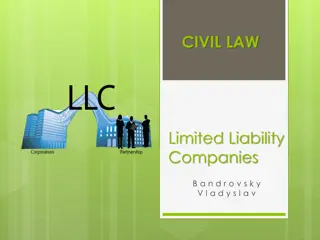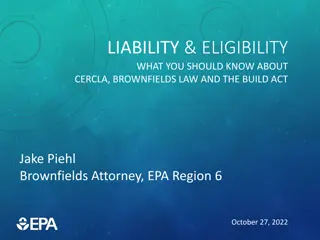Understanding Affiliated Company Liability and Employer Relationships in Labor Law
This session provides insights into affiliated company liability under labor and employment laws, discussing the implications, risks, and legal standards relevant to determining single employer status. It covers scenarios where separate entities may be treated as one employer, highlighting factors such as common ownership, management, operations, and labor control. Various relationships at risk due to expanded employer definitions are also explored.
Uploaded on Oct 04, 2024 | 0 Views
Download Presentation

Please find below an Image/Link to download the presentation.
The content on the website is provided AS IS for your information and personal use only. It may not be sold, licensed, or shared on other websites without obtaining consent from the author. Download presentation by click this link. If you encounter any issues during the download, it is possible that the publisher has removed the file from their server.
E N D
Presentation Transcript
Session Overview Affiliated Company Liability Single Employer NLRA, Alter Ego FLSA, WARN Act, ERISA Hypothetical Scenarios Mitigating Risks Questions
Affiliated Company Liability Shareholders generally not liable for the acts of the corporation and same principle is equally applicable when shareholder is another corporation. Exceptions to this rule under the labor and employment laws. Depending on the claims and legal theories being advanced, separate corporate status will be disregarded to impose liability on the parent or affiliated entity. 2
Implications and Risks Separate entities treated as one employer for purposes of labor and employment liability. Responsible parties, and sources of remedy expanded. Commonly owned entities have potential liability under almost all of the labor and employment laws (e.g. CBAs, NLRA, Discrimination laws, FMLA, WARN, ERISA, OSHA, etc.) 3
Relationships at Risk of an Expanded Definition of Employer Parent/Subsidiary Holding Company/Operating Company Brother Sister Company Double-Breasted Contractors Private Equity/Portfolio Company Joint Employer * * Typically not a matter of commonly owned company liability and not the focus here, but many such relationships implicated due to the connection between two concededly separate entities. (e.g. Horizontal Joint Employer, User/Contractor and Franchisor/Franchisee). 4
Legal Standards Used to Impose Liability Single employer, sometimes called integrated enterprise; Alter-ego; Special definitions: e.g. FLSA, WARN and ERISA among others. 5
Single Employer Four factors considered when determining whether two or more separate corporations are a single employer: Common ownership; Common management; Interrelations of operations; and Common control of labor and employee relations. This test, or slight variations applied under numerous statutes such as, NLRA, the Discrimination Laws, FMLA and OSHA. Not all factors must exist and no one factor is dispositive. Common ownership alone is not enough to result in a single employer finding. Rather, the other three factors have been deemed most important, with the greatest weight typically placed on the degree of centralized control over labor and employment matters. 6
Single Employer Factors Common Ownership Least important. Does one company hold an interest in the other? Are companies under common ownership, either directly or indirectly? Common Management Both higher level management (officers, directors, key managers) and lower level management (regional managers, plant managers, supervisor, etc.) considered. Is there any overlap of directors, officers or managers? Evidence that one company exercises control (actual or potential) over the other s day-to- day operations. 7
Single Employer Factors Interrelation of Operations Second most important factor. Functional integration: extent to which one facility or entity depends on the other or that operated as a single business unit. Operational integration: sharing of employees, equipment, customers, offices, staff, books, records, bank accounts, insurance or financial information. Shared services: centralized department serving both entities (payroll, accounting, marketing, human resources, etc.) Nature of dealings between the companies: arm s length or market rate basis. 8
Single Employer Factors Centralized Control of Labor Strategy Most important factor. Common development and implementation of strategy policies, and practices concerning Labor and Employment matter. Common or separate employment policies, different benefits, employment forms, wages rates, etc. Common or separate day-to-day supervision; decisions regarding employees such as recruiting, hiring, discipline, work assignment, resolution of grievances, terminations; and responding to workers compensation or unemployment claims. 9
How Issues Arise Under NLRA Union files UC petition or attempts to organize commonly owned non-union facility and argues it should be included with existing union facility. Grievance under CBA, information requests, ULP charge or damage lawsuit based on position that duty to bargain on labor agreement of one entity should apply to another. Liability requires a finding of single employer status under the four factors, plus a finding that the employees shared a community of interest sufficient to be grouped into the same bargaining unit. Examples:S. Prairie Const. Co. v. Local No. 627, Intern. Union of Operating Engineers, AFL-CIO, 425 U.S. 800 (1976) Oaktree Capital Mgmt., L.P. v. N.L.R.B., 452 Fed. Appx. 433 (5th Cir. 2011); Esmark, Inc. v. N.L.R.B., 887 F.2d 739 (7th Cir. 1989); Lihli Fashions Corp., Inc. v. N.L.R.B., 80 F.3d 743 (2d Cir. 1996) Alkire v. NLRB, 716 F.2d 1014, 1018 (4th Cir. 1983); Carpenters Local Union No. 1846 of United Broth. of Carpenters & Joiners of Am., AFL-CIO v. Pratt-Farnsworth, Inc., 690 F.2d 489 (5th Cir. 1982), amended, (5th Cir. Dec. 8, 1982). 10
Alter Ego Alter ego/piercing corporate veil doctrine has also been applied in the labor and employment setting typically where a new entity has replaced another entity that had labor and employment obligation. Cases often involve actions by the NLRB or unions to enforce a collective bargaining obligation on a new entity or by pension funds for delinquent contributions or attempts to collect a judgment based on employment liabilities. Generally, it is alleged that new entity is a disguised continuance of the old and for legal purposes should be treated as same entity. 11
Alter Ego Some courts look at purpose and whether new entity was created to evade or avoid obligations under the labor and employment laws. Also considered are whether the two entities have substantially identical management, business purpose, operation, equipment, customers, supervision and ownership, and extent to which it observes or fails to observe corporate formalities adhered to. Further relevant is whether entity is thinly capitalized. Examples: Newspaper Guild of New York, Local No. 3 of Newspaper Guild, AFL-CIO v. N.L.R.B., 261 F.3d 291 (2d Cir. 2001); NLRB v Al Bryant, Inc., 711 F.2d 543 (3rd Cir 1983)(cert.denied); A. Dariano & Sons, Inc., 869 F.2d at 518; Milford Services, Inc., 294 N.L.R.B. 684 (1989). 12
Special Definitions FLSA Combination: single enterprise standard (related activities and unified control) for jurisdictional purpose and jointemployer economic realities standards per the DOL s guidelines for determination of liability. Most common version of economicrealities test is whether affiliated company: Had the direct or indirect power to hire and fire the employees; Supervised and controlled employee work schedules or conditions of employment and promulgates work rules; Involvement in day-to day supervision; Determined the rate and method of payment; and Maintained employment records, including payroll, insurance, etc. Factors not exhaustive, courts consider totality of the employment circumstance. Examples: Tharp v. Energes LLC, No. 5:15-cv-983, 2016 WL 3352203, *2 (W.D. Tex. June 15, 2016); In re: Enterprise Rent-a-Car Wage & Hour Employment Practices Litigation, 683 F.3d 462 (3d Cir. June 28, 2012). 13
Special Definitions WARN Act DOL five-factor balancing test: Common ownership; Common directors and/or officers; De facto exercise of control; Unity of personnel policies emanating from a common source; and The dependency of operations. The last three factors are often determinative. Common ownership and common officers/directors are of limited significance. Further, several Courts have held that controlling company s specific direction that a plant closing or mass layoff occur without giving the requisite notice evidences of de-facto control. Frequently litigated matter with a number of cases involving claims against what seemingly are non-employers such as lenders, parent companies, or a Private Equity Fund Management Companies for alleged WARN violations. Examples: In re Jevic Holding Corp., 526 B.R. 547, 552 (Bankr. D. Del. 2014) Guippone v. BHS&B Holdings LLC. etd., 737 F3d 221 (2d Cir 2013). ; Pearson v. Component Tech. Corp., 247 F.3d 471, 483 (3d Cir. Pa. 2001); In re APA Transp. Corp. Consol. Litig., 541 F.3d 233 (3d Cir. 2008) Richards v. Advanced Accessory Sys., LLC, Case No. 09-11418, 2010 U.S. Dist. LEXIS 103613 (E.D. Mich. Sept. 30, 2010). 14
Special Definitions ERISA Both single-employer and alter ego standards have been applied to hold one entity liable for the other ERISA obligations. Also, if controlled group test met, all trade or businesses making up the controlled group have joint and several liability for withdraw liability, under funding, and PBGC premiums. Examples: Sun Capital Partners III, LP v. New England Teamsters & Trucking Indus. Pension Fund, 724 F.3d 129 (1st Cir. 2013); Sun Capital Partners III, LP v. New England Teamsters & Trucking Indus. Pension Fund, No. 10-10921-DPW (D. Mass. 2016) Cent. States, Se. & Sw. Areas Pension Fund v. Int'l Comfort Products, LLC, 3:07-CV-00383, 2011 WL 3608553, at *1 (M.D. Tenn. Aug. 16, 2011). 15
WARN/Upstream Liability The Employer is a portfolio company owned by a fund, and is engaged in manufacturing. It has permanently closed without giving required WARN notice. A lawsuit has been filed naming the employer, fund, and PE firm as Defendants for violations of WARN. The facts are as follows: Fund does not have any employees, and is the 100% owner of the entity that owns the portfolio company. PE firm manages the fund s investment in the employer/portfolio company and has a Management Services Agreement (MSA). MSA provides for financial, accounting, cash management, computer and data processing services; consulting services and labor relations and HR services to the employer/portfolio company. Under the MSA the PE firm is paid a quarterly fee, plus reasonable out-of-pocket fees and expenses for such services. Employer had a Board of Managers, majority who were employees of the PE firm. With exception of the President of Employer, who was appointed by PE firm, all officers held positions with PE firm. PE firm s General Counsel served as both the Secretary for the Employer and the PE firm. The Employer sought to sell the business as a going concern, but was unsuccessful. Upon failure to sell, the employer s creditors foreclosed and seized the plant and all equipment. Sales negotiations were handled exclusively by PE firm. Employers Board made decision to close plant without providing WARN notice. Questions: What are the labor and employment law issues and vulnerabilities? From a planning perspective, how could the responsibilities and duties been assigned to minimize risk? What actions or inactions, could the PE firm have undertaken to minimize risk and at what times? What decisions created the least amount of risk? Are there potentially third parties, outside of PE firm and Employer, liable for some of the liability? How can or should the risk of liability be balanced against the need to protect the investment? 17
NLRA/Single Employer Issues A Union representing employees at one of the parent s subsidiary companies has demanded that its CBA be applied to a newly acquired company. It has also filed a grievance under the CBA. The facts are as follows: Parent is an engineering and construction company, with separate divisions devoted to different aspects of construction. Its Industrial Services Division has several wholly owned and separately incorporated subsidiaries, some of which are unionized. These companies are engaged in maintenance, repair, upgrade, new construction and outage work for major industrial users such as power plants, refineries, cement plants, etc. Parent acquired a company in the same business line as the other entities, except the new company specialized in turbine and boiler repair at power plants. Acquired company is non-union and has a sizeable workforce. New company was folded into the Industrial Services Division and featured prominently in the Parent s marketing and advertising materials as expanding the compliment of construction services that the Parent could provide through the division. Each of the Subsidiaries, including the newly acquired company has its own officers, but shares directors with both the Parent company and other subsidiaries. 18
NLRA/Single Employer Issues Parent Company provides engineering design services and marketing. Also, as needed but not as an exclusive source, the Parent provides special equipment such as very large cranes on either a lease or rental spaces. The Parent also makes available superintendents for job site supervision which in the past have been transferred from one subsidiary to another. The Parent has dedicated HSE, Labor relations and HR staff that provide services to each of the subsidiaries which are covered as allocated overhead. Each subsidiary, however, also has its own HR manager. Employees at each of the subsidiaries have their own employee handbook and are subject to a code of conduct developed by and modeled after the code in place at the Parent. Also, each has its own wage and benefit scale. Questions: What are the key facts in this situation? What avenues might the Union take to try and expand its representation rights to the other subsidiaries? What are the labor and employment law issues and vulnerabilities? From a planning perspective what labor and HR diligence would you have suggested for this matter? What steps should be taken to fence off or minimize the possibility that the new company s liabilities or labor situation will be imputed to the Parent Company or other subs? What other variables should be considered? 19
FLSA/Single Employer and Economic Reality Holding company is the sole stockholder of 38 domestic subsidiaries. The holding company provides administrative support to the subsidiaries including, but not limited to the following: drafting of business guidelines; employee benefit plans; computer software; insurance; technology and legal services. The holding company also provides centralized human resources functions to the subsidiaries. A large number of the subsidiaries employees are classified as non-exempt for purposes of overtime pay. A group of managers and assistant managers have brought collective actions against the subsidiaries. Questions: What liability could flow from the holding company providing certain administrative support? Is the holding company at risk for being found liable for FLSA violations of the subsidiary? 20
Company Form and Compliance with Corporate Formalities Separate articles of incorporation and bylaws; Separate corporate officers (ideally, there should not be overlap, but if there is it should be kept to a minimum); Separate boards of directors (again, there should not be overlap, but if there is it should be minimal); Hold required directors meetings and maintain required corporate minutes; Create and maintain separateness over details and operation (separate tax accounts, bank account, phone numbers, tax returns, etc.) 22
Operations Employees should not be interchanged or transferred between companies; This is a critical component: employees should not be lent or borrowed between the parent company and the subsidiary (unless done on an arm s length, documented and compensated-for basis); rather, each should function as a separate employer with its own labor force; Day-to-day control of the corporations should be separate; Employees should be paid on a different basis; There should be no common supervision between the companies; Expenditures of each operation should be autonomous and should not require approval of the other, subject to possible financial covenants based on documented loans requiring approvals of amounts exceeding a certain cap; The subsidiary and the parent company should perform as few services for the other as possible. And, as noted above, when services must be performed for the other, they should be done on an arm s length basis, handled and billed just as services for other customers, etc.; The companies should not interchange tools or equipment without rental agreements and fees. 23
Day-to-Day Control of Labor and HR Relations Own labor and employment policies and practices: job applications should be unique to each company; personnel files should be maintained separately by each company; personnel policies should be unique to each company; each company should prepare and maintain its own time records. Own holiday and vacation policies and fringe benefits. 24
Day-to-Day Control of Labor and HR Relations Perhaps most critically, a subsidiary should have a person responsible for its labor relations and it should not be the same person that is responsible for the labor relations at the parent company. Different individuals should carry out high-level, employment related policies at each company (e.g., setting hours of operations; administrating and setting work rules; scheduling holidays; determining wage rates; pension plans; health and welfare plans; etc.) Different individuals should administer human resources functions at each company (e.g., scheduling time off, granting leaves of absences, vacations, etc.) 25
Day-to-Day Control of Labor and HR Relations Own set of supervisors and they should not be interchanged with the parent company. In particular, a subsidiary should make sure that it is in control of the following regarding its employees: discharging; hiring; assigning the work; transferring; scheduling time off; suspending; rewarding for work; laying off; setting wage rates; recalling; disciplining and adjusting employee promoting; grievances or complaints. 26
THANK YOU Art Carter 214.880.8105 atcarter@littler.com Robert Long 614.463.4215 rlong@littler.com Lance A. Bowling 832.513.1387 lance.bowling@cbi.com Melissa L. Dulski 301.272.1131 melissa.dulski@americancapital.com David Stegeman 920.924.4328 dstegeman@michels.us
